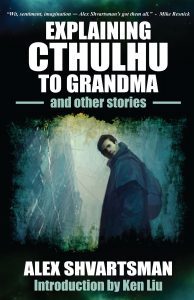Anna Tambour Guest Post–“Service Providers”
I recently asked writer X to point me to X’s fiction. X replied:
“Based on the tone/handling of your story Y, the only one of my recent stories that I think may speak to you is, possibly, ….”
As one of Wodehouse’s characters once said, “?”
The tone/handling of every story I write has much more to do with the story, I’d like to think, than the teller (me), for I always try to be invisible as a writer. Whether I succeed or not, I don’t know, but I do think that every story demands and deserves its own tone and handling, and that the job of the writer is to serve those needs.
I am hardly unique. Hans Christian Andersen purportedly was quite dedicated to making the telling of a story subservient to the story, though I would love to know both if he really did, and would also like to read an unhomogenised translation of his stories.
There have been writers such as Henry Kuttner who wrote in so many different tones/treatments and for so many markets (and in his case, in so many names) that he smothered any chance for the fame he deserves. And compare Lafferty’s “Hog-Belly Honey” with “Nine Hundred Grandmothers”. Perhaps it’s a good time now to celebrate contemporaries such as Aliette de Bodard, Jeffrey Ford, Margo Lanagan, Jeff VanderMeer, and Catherynne M. Valente for their penchants for serving their story with the invisible faithfulness and efficiency of all good service providers. They hide so well behind their stories that we forget, while in the thrall of the story, that they, the authors, exist.
Another feature of this level of service writer is the lust they have for inhabiting the bodies, psyches, and worlds of the people who tell stories in their own words. One professor who teaches creative writing told me of how the default voice of students is the first-person. Certainly, this prevalence of first-person narrative is a comment made about many anthologies. This is a pity when the voice is, as it so often is, indistinguishable from that of the person whose byline the story hangs from. Which is not at all the case with, say, Margo Lanagan’s “Singing My Sister Down” or her very different “Night of the Firstlings”.
For some easily accessible examples, read, compare and contrast these stories by two writers who have both outstanding range, and a perfect pitch for tone/handling:
- Kij Johnson’s “Spar”, “26 Monkeys: Also the Abyss”, and “The Cat Who Walked a Thousand Miles”.
- Marc Laidlaw’s “The Boy Who Followed Lovecraft”, “Leng”, and “Bellweather”.
I’m sure you can instantly think of other stories you love by authors who are quite forgettable, their stories stick with you so well.
About the Author:
Anna Tambour’s novel Crandolin was shortlisted for the World Fantasy Award. Her latest published short story is “The Walking-Stick Forest” on Tor.com, edited by Ellen Datlow. Upcoming publications include “The Old Testacles” in the September quarterly of The Cascadia Subduction Zone published by Aqueduct Press; “The Gun Between the Veryush and the Cloud Mothers” in Asimov’s; and a collection to be published by Twelfth Planet Press in 2015: The Finest Ass in the Universe. Of no fixed nationality, she lives in the Australian bush.




